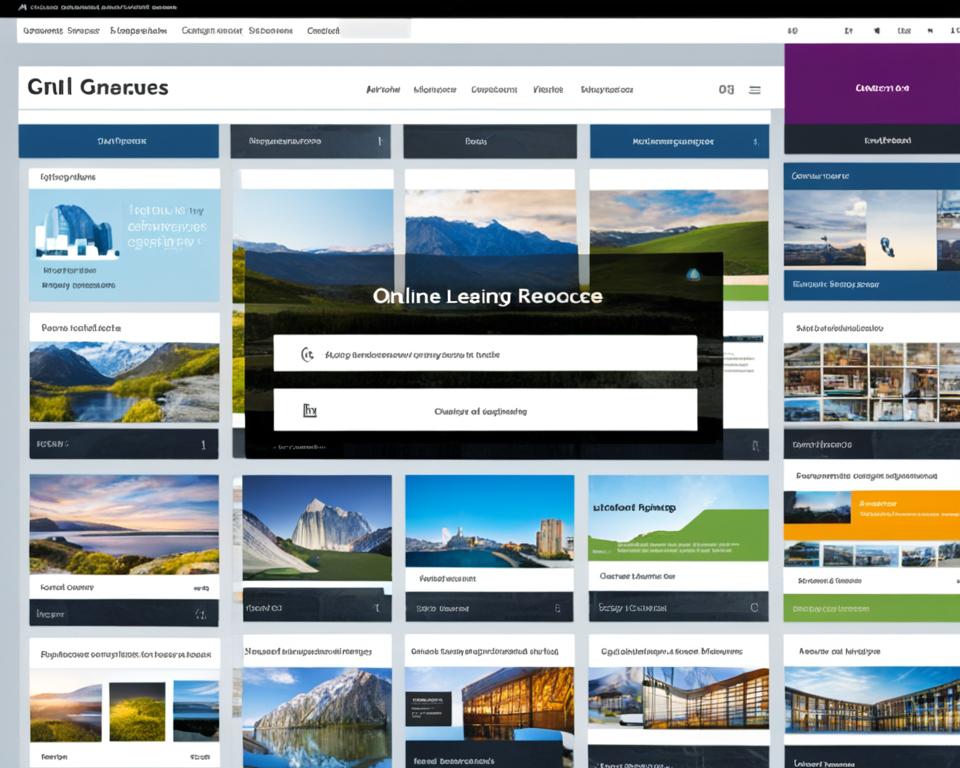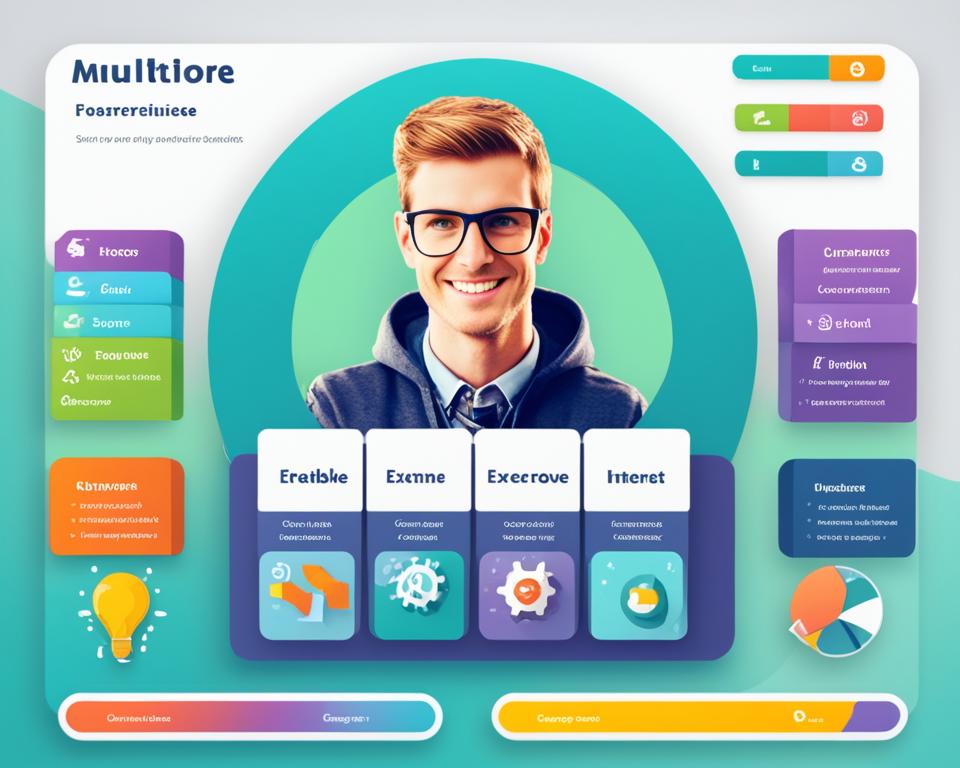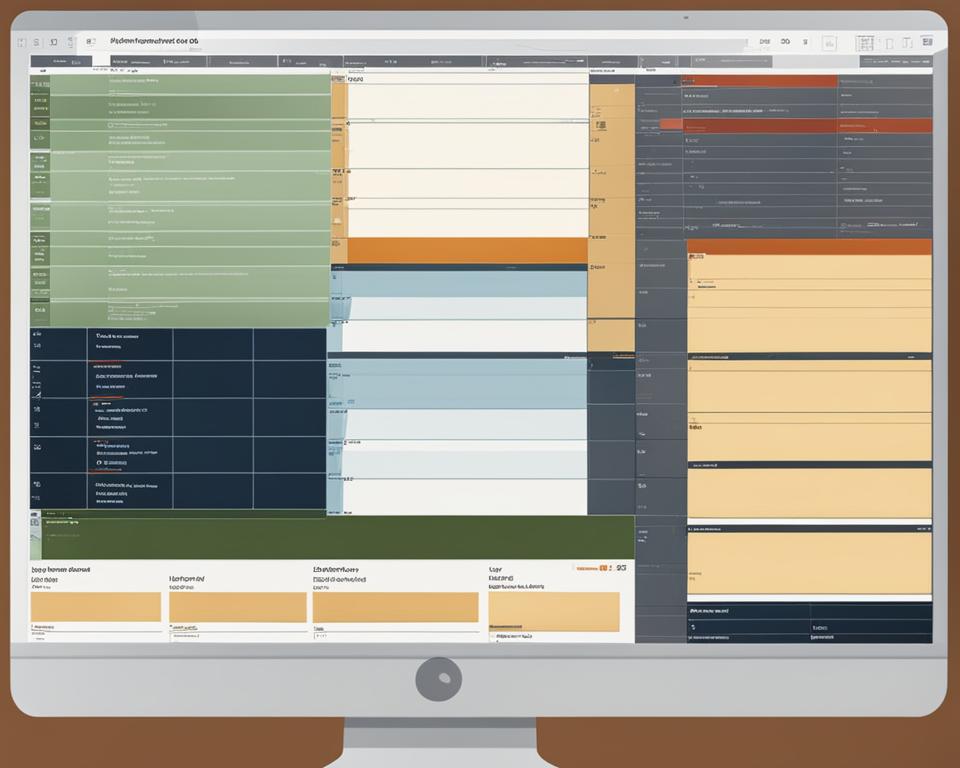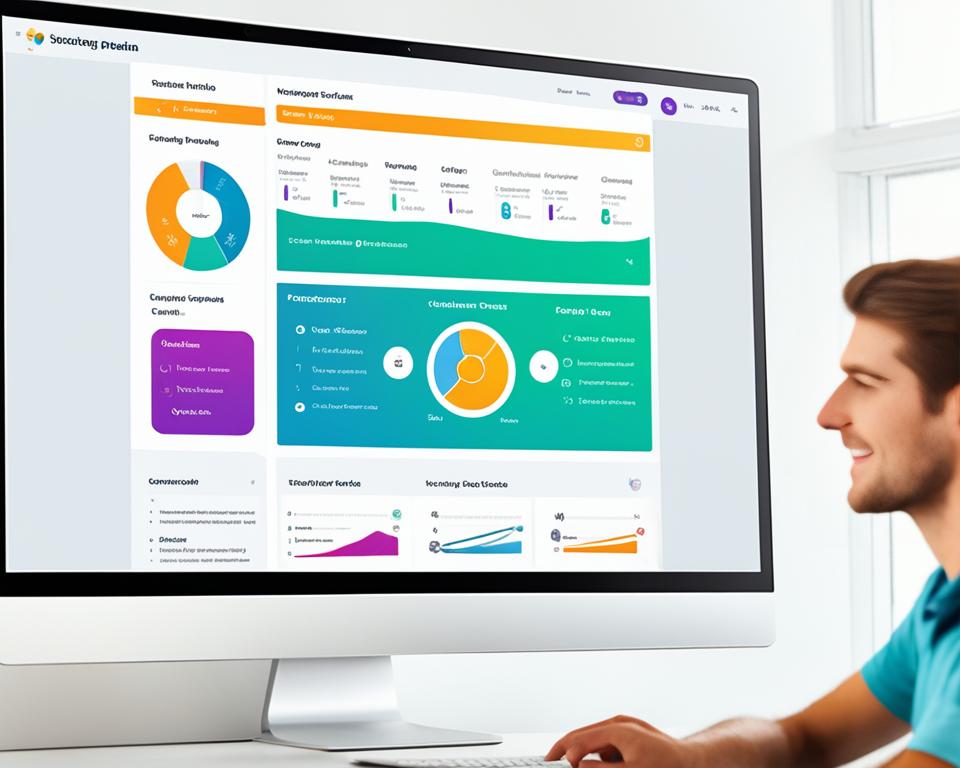Educators and trainers are facing the challenge of decreasing learner attention spans. One way to address this is through interactive educational content. By incorporating interactive elements such as games, quizzes, scenarios, simulations, and videos, learners are motivated to engage with the material, think critically, and enhance their long-term memory activation. These elements add an element of fun to learning and provide opportunities for learners to explore, fail, try again, and learn. They also serve as effective assessment tools and promote in-depth learning. Interactive educational content can be created using interactive learning software and delivered through various platforms and apps.
Key Takeaways:
- Interactive educational content enhances learner engagement and motivation.
- Incorporating games, quizzes, scenarios, simulations, and videos makes learning interactive and fun.
- Interactive elements promote critical thinking, problem-solving, and long-term memory activation.
- Interactive educational content can be created using interactive learning software and delivered through various platforms and apps.
- By using interactive educational content, educators can create effective and engaging online learning resources.
Games as Engaging Learning Aids
Games are an exceptional learning aid that adds a fun element to learning and motivates learners to perform better without realizing it. Digital games based on popular concepts like “Spin the wheel,” “Jeopardy,” and “Treasure hunt” can be highly engaging for online learners. Various game mechanics can be applied to these games to fulfill learners’ motivation for risks, challenges, rewards, and recognition. Incorporating educational games into interactive educational content enhances learner engagement and retention.
When learners are actively involved in a game, they are more likely to stay focused, absorb information, and retain knowledge in the long run. Games stimulate critical thinking, problem-solving, decision-making, and strategic planning skills. Through the interactive nature of educational games, learners are encouraged to explore, experiment, and learn from their mistakes in a safe environment.
“The use of educational games in teaching and training has been proven to have several advantages. They promote active learning, improve memory retention, enhance motivation, and provide immediate feedback.” – Researcher Dr. Jessica Williams
Furthermore, educational games provide a sense of achievement and progression, as learners can level up, unlock new challenges, and earn virtual rewards. This element of gamification fuels learners’ intrinsic motivation, making them eager to achieve their learning goals. The competitive nature of games also encourages healthy competition among learners and promotes collaboration and teamwork.
Types of Educational Games
Educational games come in various forms, catering to different subjects and learning objectives. Some examples include:
- Quiz games: These games assess learners’ knowledge through interactive quizzes and trivia challenges.
- Puzzle games: These games involve problem-solving and critical thinking to solve puzzles and challenges.
- Simulation games: These games offer realistic scenarios that allow learners to apply their knowledge and skills in a virtual environment.
- Adventure games: These games take learners on a journey where they must complete tasks and solve puzzles to progress.
By incorporating game-based learning into interactive educational content, educators can create a dynamic and engaging learning experience that captures learners’ attention and promotes active participation. With the right blend of content and game mechanics, educational games can foster a love for learning and empower learners to achieve their full potential.
| Advantages of Educational Games | Examples |
|---|---|
| Enhances learner engagement and motivation | Language learning game that uses interactive conversations to improve fluency |
| Fosters critical thinking and problem-solving skills | Math game that presents learners with real-life scenarios to solve complex equations |
| Improves long-term memory retention through interactive experiences | History game that immerses learners in historical events through interactive storytelling |
| Encourages collaboration and teamwork | Science game that requires learners to work together to conduct virtual experiments |
Quizzes and Assessments for Effective Learning
Quizzes and assessments play a pivotal role in enhancing the effectiveness of educational content. They provide learners with valuable opportunities to evaluate their knowledge, gauge their performance, and reinforce key concepts. By incorporating interactive quizzes and assessments into educational materials, educators can create engaging learning experiences that promote deep understanding and retention.
Different formats can be utilized to design interactive quizzes, such as multiple-choice questions, rapid-fire quizzes, trivia quizzes, and fill-in-the-blank questions. These formats cater to diverse learning preferences and keep learners actively engaged throughout the assessment process. Interactive quizzes provide learners with an interactive and dynamic learning experience, allowing them to test their knowledge and receive immediate feedback.
Benefits of Interactive Quizzes:
- Active learning: Interactive quizzes encourage learners to actively participate and engage their cognitive abilities, resulting in better comprehension and retention of the material.
- Formative assessment: Quizzes serve as effective formative assessment tools, providing learners with ongoing feedback and identifying areas where further study may be required.
- Flexibility: Interactive quizzes can be adapted to different subjects, levels, and learning objectives, making them suitable for a wide range of educational contexts.
- Immediate feedback: Learners can receive immediate feedback on their responses, enabling them to identify misconceptions and clarify their understanding.
- Self-paced learning: Interactive quizzes can be completed at the learner’s own pace, allowing for personalized learning experiences.
Overall, interactive quizzes and assessments contribute to the overall learning process by providing learners with a comprehensive and engaging method to test their knowledge, reflect on their performance, and reinforce important concepts. By incorporating interactive quizzes into educational content, educators can enhance learner engagement, promote knowledge retention, and facilitate a more interactive and effective learning experience.
| Benefits of Interactive Quizzes |
|---|
| Active Learning |
| Formative Assessment |
| Flexibility |
| Immediate Feedback |
| Self-paced Learning |
“Interactive quizzes provide immediate feedback and engage learners in the learning process, leading to enhanced knowledge retention and self-paced learning experiences.”
Scenarios for Real-Life Application
Scenarios are a powerful tool used in interactive educational content to recreate real-life situations that learners may encounter. By immersing learners in these scenarios, they are encouraged to make decisions and navigate through different paths, simulating real-world experiences. Through interactive scenarios, learners are presented with various possibilities and complexities that promote in-depth learning and allow them to understand the consequences of their choices.
Interactive scenarios play a vital role in engaging learners and preparing them to respond effectively in real-life situations. By presenting learners with authentic challenges and dilemmas, interactive scenarios foster critical thinking, problem-solving skills, and decision-making abilities.
“Interactive scenarios immerse learners in authentic situations, empowering them to practice real-life decision-making skills in a safe environment.” – Mark Johnson, Education Specialist
These scenarios can be designed to reflect a wide range of real-life situations across various industries and disciplines. For example, in healthcare training, learners can navigate through a medical emergency scenario, making critical decisions and assessing patients’ conditions. In business training, learners can experience scenario-based simulations of challenging negotiations or team management situations. Through interactive scenarios, learners gain practical experience, learn from their mistakes, and develop the skills necessary to handle similar situations in real-life settings.
The Benefits of Interactive Scenarios:
- Enhance critical thinking and problem-solving skills.
- Promote learner engagement and active participation.
- Allow learners to experience the consequences of their choices.
- Encourage exploration and experimentation.
- Provide a safe and controlled learning environment.
By incorporating goal-driven immersive learning scenarios and fact-based scenes, interactive educational content stimulates learners’ cognitive engagement and enables them to apply their knowledge in realistic contexts.
Take a look at the interactive image below to see an example of an immersive scenario:
Simulations for Hands-On Learning
Simulations provide learners with the opportunity to engage in hands-on learning experiences in a risk-free environment. They allow learners to apply their knowledge and skills to real-world scenarios, enhancing their understanding and competence in a practical setting.
There are different types of interactive simulations that can be incorporated into educational content to create engaging learning experiences:
- Role-Based Simulations: These simulations immerse learners in a specific role or profession, allowing them to assume the responsibilities and make decisions as if they were in a real-world setting. This type of simulation is commonly used in fields such as healthcare, emergency response, and customer service.
- Process-Based Simulations: Process-based simulations guide learners through a step-by-step process or procedure, enabling them to practice and refine their skills. This type of simulation is often used in technical training and manufacturing industries.
- Explorative Simulations with Multimedia: Explorative simulations incorporate multimedia elements such as videos, images, and interactive components to create an immersive learning experience. Learners can explore different scenarios, analyze data, and experiment with various approaches to deepen their understanding of complex concepts.
- Screen-Component Simulations for Software Training: Screen-component simulations simulate the use of software applications, allowing learners to interact with the virtual interface. This type of simulation is particularly useful for software training and IT-related courses.
By engaging learners in interactive simulations, educators provide them with valuable hands-on experience that reinforces critical concepts, processes, and procedures. Learners can make mistakes, learn from them, and explore different possibilities in a controlled environment.
“Simulations bridge the gap between theory and practice, offering learners a safe space to apply their knowledge and gain practical skills.” – Education Expert
The hands-on nature of simulations promotes active learning, critical thinking, problem-solving, and decision-making skills. Learners gain confidence and competence in real-world scenarios, preparing them for future challenges and contributing to their overall development.
Benefits of Simulations for Hands-On Learning
| Benefits | Description |
|---|---|
| Enhanced Understanding | Learners gain a deeper understanding of complex concepts and processes by experiencing them firsthand in a simulated environment. |
| Application of Knowledge | Simulations allow learners to apply their knowledge and skills to real-world scenarios, preparing them for practical challenges. |
| Risk-Free Environment | Learners can make mistakes, experiment, and learn from their experiences without any real-world consequences. |
| Engagement and Motivation | The interactive nature of simulations provides a high level of engagement, motivating learners to actively participate in the learning process. |
| Transferable Skills | Through simulations, learners develop transferable skills such as critical thinking, problem-solving, and decision-making that can be applied in various contexts. |
The use of simulations in hands-on learning provides a powerful educational tool that not only enhances learner engagement and motivation but also equips them with practical skills and real-world experience.

Videos as Engaging Learning Tools
Videos have become one of the most powerful communication tools for engaging learners in the digital age. They have the ability to transform passive content into an active learning experience, capturing the attention of learners faster than any other media. When it comes to conveying complex information effectively, videos are unparalleled in their impact.
But what makes videos even more engaging is when they become interactive. Interactive videos provide learners with the opportunity to personalize their learning experience, enabling them to navigate through the content, interact with informative overlays, and even participate in quizzes. By incorporating interactive videos into educational content, learners are no longer passive observers but active participants in the learning process.
With interactive videos, learners have the flexibility to explore various paths and choose their own learning journey. They can pause, rewind, or skip portions of the video based on their individual needs and preferences. This learner-centric approach promotes a more immersive and memorable learning experience.
| Advantages of Interactive Videos | Examples |
|---|---|
| Engages learners actively in the learning process | Virtual tours that allow learners to explore historical landmarks |
| Enhances understanding of complex concepts through interactive overlays | Videos with pop-up definitions to clarify technical terms |
| Provides immediate feedback through interactive quizzes | Video lessons with embedded quizzes to test comprehension |
| Supports personalized learning by allowing learners to control the pace | Language learning videos with adjustable playback speed |
Interactive videos also foster collaboration and active learning in group settings. Learners can engage in discussions about the content, analyze different perspectives, and share their insights. The interactive nature of videos encourages critical thinking and promotes a deeper understanding of the subject matter.
By incorporating videos as interactive learning tools, educators can capture and maintain learner interest while delivering educational content in an engaging and effective way. Whether it’s explaining complex concepts, demonstrating procedures, or showcasing real-life examples, interactive videos have the power to create meaningful learning experiences that leave a lasting impact on learners.
Interactive Learning Platforms and Apps
Interactive educational content can be delivered through various platforms and apps designed specifically for interactive learning. These platforms and apps provide a user-friendly interface and tools for creating and accessing interactive educational content. They offer features like progress tracking, personalized learning paths, and interactive elements. By utilizing interactive educational platforms and interactive educational apps, educators can create engaging learning experiences and enhance learner accessibility.
Interactive learning platforms and apps offer a wide range of benefits for both educators and learners. Educators can easily design and customize interactive content according to their teaching goals and learning objectives. They can create interactive quizzes, games, simulations, and scenarios that cater to different learning styles and preferences. These platforms and apps also provide real-time analytics and data tracking, allowing educators to monitor learner progress and identify areas for improvement.
Learners, on the other hand, benefit from the flexibility and convenience of accessing interactive educational content anytime, anywhere. They can personalize their learning experience by selecting specific topics or modules that align with their interests or learning needs. Interactive elements like quizzes and assessments provide immediate feedback, helping learners gauge their understanding and make necessary adjustments. Additionally, interactive learning platforms and apps often incorporate social features, allowing learners to collaborate, share ideas, and learn from their peers.
Below is a comparison table highlighting some popular interactive educational platforms and apps:
| Platform/App | Key Features |
|---|---|
| Canvas | Robust learning management system with interactive tools, video conferencing capabilities, and integration with third-party apps. |
| Kahoot! | Engaging game-based learning platform with customizable quizzes, polls, and surveys. |
| Google Classroom | User-friendly platform for creating and sharing interactive assignments, discussions, and resources. |
| Edmodo | Social learning platform that facilitates communication, collaboration, and content sharing. |
These interactive educational platforms and apps are just a few examples of the many tools available to enhance online learning experiences. Educators can explore these options to discover the most suitable platform or app for their specific needs and teaching style. By harnessing the power of interactive technology, educators can create dynamic and engaging learning environments that promote active participation, knowledge retention, and skill development.
Benefits of Interactive Educational Content
Interactive educational content provides numerous benefits for learners. By incorporating multimedia elements and interactive features, digital educational content enhances engagement, motivation, and attention span, resulting in more effective learning experiences.
Increased Learner Engagement and Motivation
Interactive educational content captivates learners by offering a dynamic and immersive learning environment. The inclusion of multimedia learning resources, such as videos, images, and animations, stimulates curiosity and holds learners’ attention. With engaging content, learners are motivated to actively participate in the learning process, leading to a deeper understanding and retention of information.
Promotion of Critical Thinking and Problem-Solving Skills
Through interactive educational content, learners are encouraged to think critically, analyze information, and solve problems. Activities like interactive quizzes, simulations, and scenarios prompt learners to apply their knowledge and skills in real-life situations. This promotes the development of critical thinking, problem-solving, and decision-making abilities, which are crucial in various academic and professional contexts.
Enhanced Long-Term Memory Activation
Interactive educational content facilitates long-term memory activation by employing various strategies such as spaced repetition, retrieval practice, and interleaving. By providing learners with opportunities to revisit and reinforce key concepts through interactive exercises, educational content strengthens memory formation and retrieval. This supports the transfer of knowledge to long-term memory, ensuring a more lasting impact on learners’ educational journeys.
Personalized Learning and Immediate Feedback
With interactive educational content, learners can personalize their learning experience based on their individual preferences and needs. Digital platforms and apps offer features like progress tracking and personalized learning paths, allowing learners to advance at their own pace. Additionally, interactive elements provide immediate feedback and assessment, enabling learners to gauge their understanding, identify areas for improvement, and make adjustments in real-time.
Interest and Memorability through Multimedia Elements
Multimedia learning resources, such as videos, images, and interactive visuals, make educational content more interesting, engaging, and memorable. Visual and auditory cues aid in information processing and retention, improving learners’ comprehension and recall. Interactive videos, for instance, encourage learners to actively participate, navigate content, and interact with visual overlays, reinforcing key concepts and enhancing overall learning outcomes.
Incorporating interactive elements and multimedia learning resources into educational content transforms the learning experience into an exciting and effective journey. By leveraging the benefits of digital educational content, educators can create engaging, personalized, and impactful learning experiences that empower learners to thrive in their educational pursuits.
Creating Engaging and Interactive eLearning Courses
Creating engaging and interactive eLearning courses requires careful instructional design and utilization of multimedia elements. By incorporating interactive elements such as quizzes, games, simulations, and scenarios, educators can keep learners actively involved in the learning process. These interactive activities provide hands-on experiences and encourage learners to apply their knowledge in real-life situations.
Multimedia elements such as images, videos, animations, and audio clips play a crucial role in enhancing the learning experience. They make the content more visually appealing and reinforce key concepts. For example, using interactive videos allows learners to actively participate and navigate through the content at their own pace.
Designing courses to be mobile-friendly is essential in today’s digital world. It enhances accessibility and flexibility, allowing learners to access the content anytime, anywhere using their preferred device.
To further increase learner engagement and retention, personalizing the learning experience is important. This can be achieved by incorporating real-life scenarios and providing opportunities for feedback. Learners feel more connected to the content when they can relate it to their own experiences and receive personalized guidance.
By creating engaging and interactive eLearning courses, educators can effectively capture learners’ attention and facilitate meaningful learning experiences. It is essential to leverage online learning resources and interactive learning tools to provide an immersive and effective learning environment.

Example of an Engaging and Interactive eLearning Course Design
| Course Module | Interactive Elements |
|---|---|
| Introduction to History |
|
| Mathematics Fundamentals |
|
| Language Skills Development |
|
By incorporating these interactive elements, learners are actively engaged in the learning process, improving their understanding and retention of the subject matter.
Conclusion
Engaging and interactive eLearning courses are vital in today’s educational landscape to combat diminishing learner attention spans. By incorporating elements such as games, quizzes, scenarios, simulations, and videos, educators can foster learner engagement, motivation, and long-term retention. The use of interactive learning software enables the creation of dynamic and immersive educational content, which can be delivered through a variety of platforms and apps for accessibility and convenience.
Following instructional design best practices is crucial in creating effective eLearning courses. By incorporating interactive elements, such as gamification and multimedia, educators can make the learning experience more enjoyable and impactful. Additionally, making eLearning courses mobile-friendly allows learners to access content anytime, anywhere, while personalizing the learning experience caters to individual preferences and needs.
Integration of real-life scenarios and providing opportunities for feedback further enhances learner engagement and enables them to apply learned concepts in practical situations. By following these tips and utilizing instructional design principles, educators can develop eLearning courses that captivate learners, promote meaningful learning experiences, and ultimately drive success in online education.
FAQ
What is interactive educational content?
Interactive educational content refers to learning materials that incorporate interactive elements such as games, quizzes, simulations, scenarios, and videos. These elements engage learners, promote critical thinking, and enhance long-term memory activation.
How can games be used in education?
Games can be used as learning aids to make education more engaging and motivating. Educational games based on popular concepts like “Spin the wheel,” “Jeopardy,” and “Treasure hunt” can be highly interactive and effective in promoting learning.
How do quizzes and assessments enhance learning?
Quizzes and assessments provide learners with opportunities to test their knowledge, measure their performance, and reinforce key concepts. They encourage critical thinking and help learners gauge their understanding of the material.
What are scenarios in interactive educational content?
Scenarios are used to recreate real-life situations that learners might encounter. They encourage learners to make decisions and navigate through different paths, promoting in-depth learning and helping learners understand the consequences of their choices.
How do simulations contribute to hands-on learning?
Simulations allow learners to practice in a risk-free environment and apply their knowledge to real-world applications. They engage learners in hands-on experiences and enhance their understanding of critical concepts, processes, and procedures.
How can videos be used as learning tools?
Videos are powerful tools that engage learners and convey complex information effectively. Interactive videos take engagement further, allowing learners to personalize their experience, interact with informative overlays, and participate in quizzes.
What are interactive learning platforms and apps?
Interactive learning platforms and apps are designed specifically for interactive educational content. They provide a user-friendly interface and tools for creating and accessing interactive learning materials. They offer features like progress tracking, personalized learning paths, and interactive elements.
What are the benefits of interactive educational content?
Interactive educational content increases learner engagement, motivation, and attention span. It promotes critical thinking, problem-solving skills, and long-term memory activation. It can be personalized and offers immediate feedback, making the learning experience more interesting and effective.
How can educators create engaging and interactive eLearning courses?
Educators can create engaging and interactive eLearning courses by incorporating interactive elements such as quizzes, games, simulations, and scenarios. They can also utilize multimedia elements like images, videos, animations, and audio clips. Designing courses to be mobile-friendly and personalizing the learning experience further enhance learner engagement and retention.
Why is engaging and interactive educational content important?
Engaging and interactive educational content is important because it addresses the challenge of decreasing learner attention spans. It enhances learner engagement, motivation, and long-term retention, providing effective learning experiences that capture learners’ interest and promote meaningful learning.





